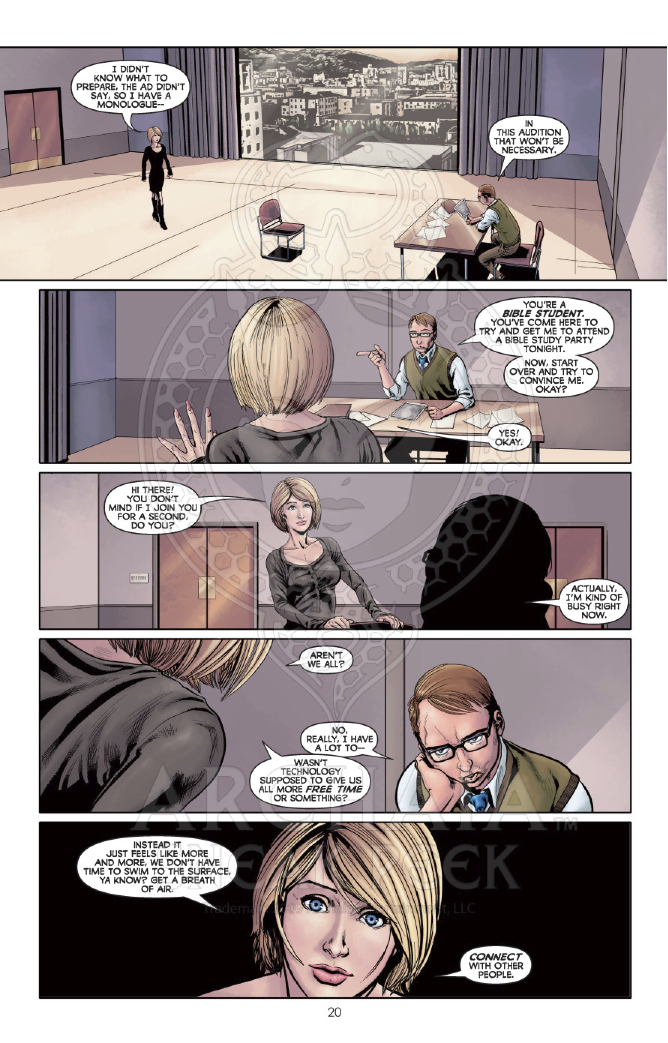Reading Syndrome, the debut graphic novel
from writers Daniel Quantz and R.J. Ryan, its hard not to have your
breath taken away. The story is both outrageous yet fascinating, the
artwork simple yet shocking and the characters familiar yet
different.
Itís 2010 and a notorious killer, dubbed The
Bible Killer, is about to be put to death in Arkansas. At the last
minute a brilliant, noble- intentioned doctor swoops in and takes
The Bible Killer to a secret facility. With the help of a slightly
crazy Hollywood art director and production designer and an out of
luck actress looking for her big break the doctor is about to
perform the greatest social experiment known to man with the
ultimate prize waiting at the end, the ability to cure evil. He sets
up a Truman Show like experiment where the Bible Killer will
constantly be tested, in a controlled environment that he thinks
real is but in fact is completely staged.

Quantz and Ryan aim high with their first graphic
novel. Syndrome toys with the idea of personal freedoms and
the ability of someone to encroach on the freedoms of someone else,
even a killer, to potentially benefit the greater good. That idea of
Ďfor the greater goodí is behind a lot of Syndrome. Luckily
the comic doesnít become preachy with its noble intentions; instead
itís optimistic, idealistic but a little flawed. A world free of
rape and murder would indeed be fantastic, but should we attempt to
create it any cost? Ultimately, thatís what Syndrome is
asking you and youíll find the answer a bit murkier than youíd
think. Prepare to feel a little cheated though as the ending of this
particular tale is wrapped up a little too quickly. (SPOILER) I
thought this was going to be a self-contained graphic novel, but it
feels like there must be a plan for more because there was a
definite Ďto be continuedí ending that leaves you with a lot of
unanswered questions. Sure they didnít have to wrap everything up
but thereís no real closure whatsoever.
Quantz and Ryanís story is aided by some really
tight editing. The flashbacks and changes in perspective, by and
large, feel like theyíve been implemented at the right time and the
way they frame and parallel certain panels allows for a few genuine
shocks and a great deal of insight into some of the characters.
Overall, itís an extremely well put together book that has a nice
flow to it.
I found myself invested in the characters and
this mainly occurred with Alexei, the art and production designer,
and the doctor. The doctor was a very well rounded character and
Quantz and Ryan put a lot of effort into developing his motivations,
his background and his goals. You fully understand where heís coming
from and what heís doing but you wonder whether heís tainted by his
past. Similarly you understand why Alexei is partaking in the
experiment but you arenít given very much background and you donít
know his goal, which makes him a little mysterious and interesting.
Also he seems a little crazy at times although sadly that aspect
wasnít developed enough. Quantz and Ryan also make the experiment
feel like a character. Itís a truly amazing idea and fully justifies
its Truman Show comparison.
Probably the only downside is the fact that
Syndrome is a wordy book. On the whole itís generally a well
written book with some great conversations between characters but
there is a lot, if not too much, dialogue and at times it can be a
lot to process along with the artwork. There are panels that are
filled with dialogue and narration but, interestingly, theyíll also
implement a series, like when Alexei is looking at his model, of 11
panels that contain no dialogue. The book seemed to jump from one
extreme to the other. Funnily enough they were able to demonstrate
an ability to speak through their art, which is no small feat. While
the dialogue was too much sometimes, it did help to give Syndrome
a very well developed supporting cast where you had a sense of what
all the minor players, like the casting guy, were like due to their
dialogue.
David Marquezís artwork and design is clean,
clear and well thought out and contributes much to the successes in
the editing mentioned above. Itís equally as much about what Marquez
leaves out of the panel as it is what he leaves in it. The comic
also has some intense violence but it fits the nature of the comic.
The Bible Killer needs to be portrayed as intensely evil to almost
justify what is going on and to provide the reader with a reason why
such drastic measures must be taken. Also the fact that Marquez has
chosen an art style grounded in realism thatís quite detailed helps
to sell the grand social experiment idea, which wouldnít have worked
so well with an out-of-the-box art style. One irksome thing about
the artwork was the use of black in some of the blood. It was
annoying because earlier there was just the use of a bright red and
then all of a sudden they through in this black. Itís mainly an
issue of having consistency throughout the comic and a testament to
the art that only such a minor fault was found.
Syndrome
contains some interesting characters, a brilliant and thought
provoking plot and setting coupled with some solid artwork that
really suits the piece. The major downside is the unending which
feels too unfinished for a self-contained graphic novel. The reader
has no closure on anything really and itís a thoroughly frustrating
end to an otherwise great book.